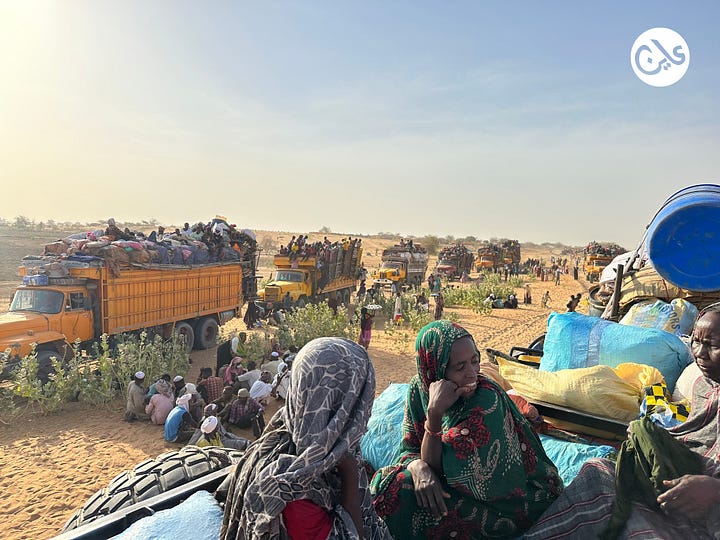🎥 Women helping women
Jebel Marra women aid displaced families from El Fasher
Watch as women volunteers in the Jebel Marra area of Darfur provide food to displaced people fleeing the fighting in the city of El Fasher.
As millions of Sudanese men have mobilized for war to fight and kill each other, Sudanese women have taken up the difficult task of feeding and caring for one another amid increasing scarcity and economic collapse.
An estimated 436,000 people in Greater Darfur face “catastrophic levels of food insecurity”—tantamount to a famine or nearly a famine situation—between now and September, according to a forecast yesterday by an international famine watchdog. Another seven million people in Darfur face “crisis” or “emergency” levels of food insecurity, which is below the famine threshold but still serious.
The above video was filmed in territory controlled by the Sudan Liberation Movement/Army led by Abdel Wahid al-Nur (SLM/A-AW), which rebelled against the Sudanese government in the early 2000s but has stayed neutral in the ongoing civil war between the Sudanese army and its former paramilitary ally, the RSF.
SLM/A-AW is one of the few armed groups in Sudan that encourages women to join its ranks. The cameraman of the above video is affiliated with SLM/A-AW and he praises the women for their role in growing food and also defending Jebel Marra. In the narration of this video, he says,
“[Greetings] to the supreme commander in the liberated areas, Abdelgadir Abdelrahaman Ibrahim Gadoura, and the commander and president of the civil authority, Naguib al-Rahman Mohamed al-Zubeir.”
“Greetings to all the officers, non-commissioned officers, soldiers, and all the sectors in the Sudan Liberation Movement/Army (SLM/SLA) project, and all those who contributed to the SLM/SLA.”
“Greetings to all the offices, domestic and international, and greetings to the women as well. Again, greetings to the Women's League. She carries the weapon in her right hand, the hoe in her left hand, the baby on her back, and the food on her head that she takes to the front defense of the SLM/SLA in the Niertiti division, since the entrance of the SLM/A.”
“Daily food from the citizens and the displaced in the Niertiti division is provided daily. Greetings to them, and greetings to the Sudanese women and the displaced women, the defenseless, who have been in detention since 21 years ago to date, greetings to them.”
Thousands of El Fasher residents have fled to the SLM/A-AW territory in central Darfur, seeking shelter from ongoing clashes in that city, while others crossed the desert north toward Sudan’s Northern State, which borders Egypt. Below are photos of El Fasher evacuees, published by Ayin Sudan, an independent media house covering human rights, humanitarian affairs, conflict, and other issues.




Darfur Victims Support, a nonprofit organization that shared the above video on social media, announced a fundraiser to help feed displaced people at one of the Darfur camps. The camps are among the populations in Sudan most at risk of famine, according to the IPC analysis released yesterday.
Sudan’s current war has its origins in the Darfur conflict that began 20 years ago after SLM-AW and other groups rebelled against the government. Sudan’s Islamist military government at the time, led by Omar al-Bashir, directed weapons and money to militias colloquially called the Janjaweed, which eventually formed into a larger and better organized paramilitary called the Rapid Support Forces (RSF).
RSF played a role in undermining a civilian uprising against military rule, massacring protesters in 2019 and participating in a military coup to halt a brief period of civilian rule after the fall of Omar al-Bashir.
Eventually, however, the RSF had a falling out with the Sudanese military and fighting erupted between the two sides in April 2023 and has continued until now.
Related coverage:
Understanding the fighting in El Fasher
Fighting in and around the North Darfur capital El Fasher has killed hundreds of people in recent weeks and forced thousands to flee, amid warnings of an impending famine that could kill thousands more.


